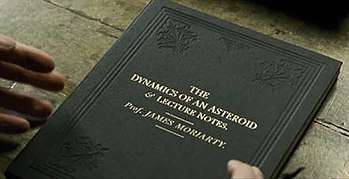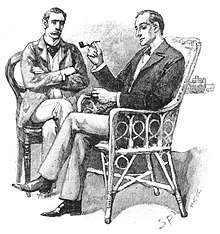The Dynamics of an Asteroid
The Dynamics of An Asteroid is a fictional book by Professor James Moriarty, the implacable foe of Sherlock Holmes. The book is described by author Arthur Conan Doyle in The Valley of Fear (written in 1914, but set in 1888) when Sherlock Holmes, speaking of Professor Moriarty, states:
Is he not the celebrated author of The Dynamics of an Asteroid, a book which ascends to such rarefied heights of pure mathematics that it is said that there was no man in the scientific press capable of criticizing it?[1]
— Sherlock Holmes, The Valley of Fear

With this class of talent, Professor Moriarty evoked the profound respect of Sherlock Holmes, one of the few opponents to do so (Irene Adler being another).
Doyle also portrayed Professor Moriarty as the author of "a treatise on the binomial theorem", written when he was only 21 years of age. In addition to covering a different topic, it must have been quite a bit more accessible, since it got him a position as a chair of mathematics at a provincial university.
Related real works
In 1809, Carl Friedrich Gauss wrote a ground-breaking treatise[2] on the dynamics of an asteroid (1 Ceres). However, it was understood immediately[3] and his method is still used today (see Gauss's method).
Two decades before Arthur Conan Doyle's writing, the Canadian-American dynamic astronomer Simon Newcomb had published a series of books analyzing motions of planets in the solar system.[4] The notoriously spiteful Newcomb could have been an inspiration for Professor Moriarty.[5]
An example of mathematics too abstruse to be criticized is the letters of Srinivasa Ramanujan, sent to several mathematicians at the University of Cambridge in 1913.[6] Only one of these mathematicians, G. H. Hardy, even recognized their merit. Despite being experts in the branches of mathematics used, he and J.E. Littlewood added that many of them "defeated me completely; I had never seen anything in the least like them before." Holmes says only that "it is said" (emphasis added) that no one in the scientific press was capable of criticizing Moriarty's work; he stops short of recognizing the claim as indisputably accurate.
Discussion of possible book contents
Doyle provided no evidence relating to the contents of Dynamics. This has in no way prevented people from speculating about what it contained.
- One esoteric branch of mathematics associated with asteroid dynamics is chaos theory. This was not appreciated by other mathematicians until the work of Henri Poincaré in 1890,[7][8] whereas Dynamics was already famous in 1888. So it is possible that Dynamics contained an early exposition of this theory.[9]
Other speculation on this topic includes:
- "The Ultimate Crime", short story by Isaac Asimov, in Sherlock Holmes Through Time and Space,[10] and in More Tales of the Black Widowers.[11]
- "The Dynamics of An Asteroid", short story by Robert Bloch, The Baker Street Journal, 1953, and also found in The Game Is Afoot.[12]
- "The Adventure of the Russian Grave," short story by William Barton and Michael Capobianco, collected in "Sherlock Holmes in Orbit".[13]
- In the novel Spider-Man: The Revenge of the Sinister Six, by Adam-Troy Castro, a veiled reference is made to Moriarty and his Dynamics. Here the work is said to still be the authority on orbital bombardment.
Related references in media
- In "His Last Vow", the final episode of series 3 of the BBC television series Sherlock, Sherlock's mother, M.L. Holmes, is shown to have written a lengthy textbook with the title The Dynamics of Combustion, a reference to this book.
- In "Henny Penny the Sky Is Falling", the 100th episode of the CBS television series Elementary, the plot evolves around a fictional paper with the title Miscalculating Near-Earth Asteroids and the Threat to Human Existence.
- The pastiche novel Professor Moriarty: The Hound of the D'Urbervilles by film critic and horror novelist Kim Newman includes a chapter parodying both "The Adventure of the Red-Headed League" and H. G. Wells's novel The War of the Worlds, in which an arrogant former student of Moriarty's named Nevil Airey-Stent publicly rubbishes The Dynamics of an Asteroid to prove that it is indeed susceptible to criticism, prompting an enraged Moriarty to orchestrate an elaborate plan to drive Stent insane by convincing him that he has been contacted by visitors from the planet Mars.
Citation analysis
Citation analysis, which involves examining an item's referring documents, is used in searching for materials and analyzing their merit. Since citation analysis does not look at a document's contents, only references to it, it can be applied to a documents such as Dynamics or Treatise that do not in fact exist.
Dynamics is referenced in the professional scientific literature[14][15] and in textbooks.[16]
The list in the previous section shows 42 references to Dynamics and 27 to Treatise, which are a lower limit, since the list is not up to date. An online search, as of 2005, for these titles with author Moriarty, reveals 263 references to Dynamics and 209 to Treatise. These are very high numbers for any scientific paper, where the overall average is about 6 references. They are even more numerous when compared to other papers from the same era – by 1900, the Royal Society's Catalog of Scientific Papers already listed 800,000 papers from 3,000 journals.[17] Most of these have been forgotten, and only a few are still referenced today, as shown by analyses of references to old scientific articles.[18]
The Dynamics of An Asteroid is among the select group of Victorian scientific works that are still remembered and referenced even today, despite (or perhaps because of) its fictional existence.
See also
- A Treatise on the Binomial Theorem, another fictional work by Moriarty
References
- A.C. Doyle (1929). The Complete Sherlock Holmes Long Stories. Murray, London. p. 409. ISBN 978-0-7195-0356-6.
- Gauss, Carl Friedrich (1809). Theoria motus corporum coelestium in sectionibus conicis solem ambientium. Friedrich Perthes and I.H. Besser, Hamburg, Germany.
- Donald Teets, Karen Whitehead, 1999, The Discovery of Ceres: How Gauss Became Famous, Mathematics Magazine, Vol. 72, No. 2 (Apr., 1999), pp. 83-93
- Marsden, B. (1981) "Newcomb, Simon" in Gillespie, C.C. (ed.) (1981). Dictionary of Scientific Biography. 10. New York: Charles Screibner's Sons. pp. 33–36. ISBN 0-684-16970-3.
- Schaefer, B. E., 1993, Sherlock Holmes and some astronomical connections, Journal of the British Astronomical Association, vol.103, no.1, p.30-34.
- Kanigel, R. (1991). The man who knew infinity: A life of the genius Ramanujan. Scribner. ISBN 978-0-671-75061-9., p. 168.
- Poincaré, Jules Henri (1890). "Sur le problème des trois corps et les équations de la dynamique. Divergence des séries de M. Lindstedt". Acta Mathematica. 13 (1–2): 1–270. doi:10.1007/BF02392506.
- Diacu, Florin; Holmes, Philip (1996). Celestial Encounters: The Origins of Chaos and Stability. Princeton University Press.
- Jenkins, Alejandro (2013). "On the Title of Moriarty's' Dynamics of an Asteroid'". arXiv:1302.5855 [physics.pop-ph].
- I. Asimov and C.G. Waugh (1985). Sherlock Holmes Through Time and Space. Severn House (UK). pp. 339–355. ISBN 978-0-312-94400-1.
- I. Asimov (1976). More Tales of the Black Widowers. Doubleday. ISBN 978-0-385-11176-8.
- Marvin Kaye, ed. (1994). The Game is Afoot. St Martin's Press (USA). pp. 488–493. ISBN 978-0-312-11797-9.
- Mike Resnick and Martin H. Greenberg, ed. (1997). Sherlock Holmes in Orbit. Fine Communications. ISBN 978-0-886-77636-7.
- Wesson, P.S. (2002). "On higher-dimensional dynamics". Journal of Mathematical Physics. 43 (5): 2423–2438. arXiv:gr-qc/0105059. Bibcode:2002JMP....43.2423W. doi:10.1063/1.1462418., Pre-print at arXiv.org
- Lutz D. Schmadel, Dictionary of Minor Planet Names, International Astronomical Union. p. 434, background for name of asteroid (5048) Moriarty.
- Mehlmann, A. (2000). The Game's Afoot!: Game Theory in Myth and Paradox. American Mathematical Society. ISBN 978-0-8218-2121-3.
- Roberto de Andrade Martins. "Strategies for the Development of Databases - History of Science, Medicine and Technology. Bibliography of Primary Sources: Articles". Archived from the original on 2005-12-26.
- Marx, Werner & Cardona, Manuel (2004). "Blasts from the past". Physics World. IOP PUBLISHING LTD. 17 (2): 14–15. doi:10.1088/2058-7058/17/2/21.
External links
- List of many references to Dynamics, as well as other works of Moriarty, Holmes, and others.
